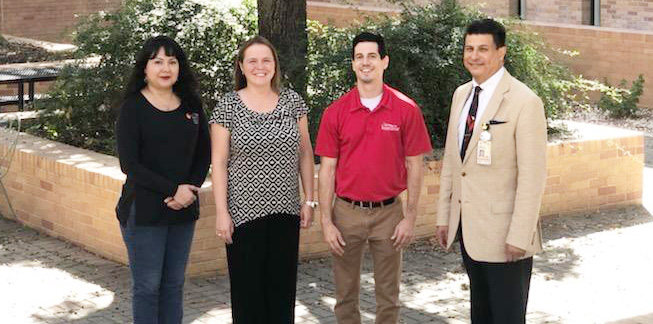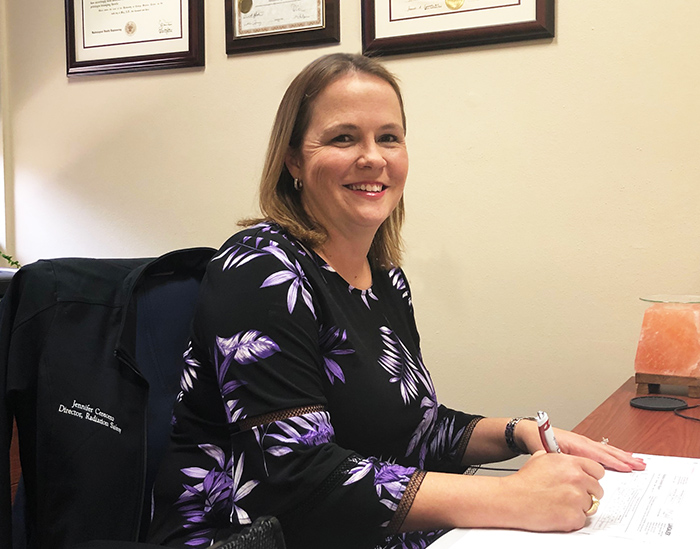Futuristic MRI scanners and X-ray devices can be seen throughout UT Health San Antonio’s campuses. Inspecting and assuring these advanced radiology medical devices often proves to be a daunting task, but they’re no match for one very important staff member.
Meet Jennifer Cerecero, M.S., director of radiation safety at UT Health San Antonio. During her 16 years of service with the Department of Environmental Health and Safety, she has managed radiation safety for UT Health San Antonio’s Long campus, Medical Arts & Research Center, Greehey Children’s Cancer Research Institute, Texas Research Park, UT Health Hill Country, UT Health Laredo, Mays Cancer Center and the University Hospital System (on contract).
Cerecero’s team of four safety specialists and two graduate teaching assistants continuously audit, inspect and evaluate every radiation medical device at UT Health San Antonio. These devices include X-ray machines, CT scanners, radiographics, and even radioactive materials. This incredible team also works with state radiation inspectors and physicists on device evaluations.

“The state regulations and compliances on radiation are constantly changing,” said Cerecero, who is certified by the Texas Department of State Health Services and is a member of the Health Physics Society. “Our division gets up to 20 state inspections a year, and they are all unannounced. That’s why all of us relentlessly monitor and evaluate all radiation devices and material usage 24/7.”
Originally from Brownsville, Texas, Cerecero was always interested in building things. When her grandfather went through complex open heart surgery, she decided to study medical engineering to improve lives for people like her grandfather.
Cerecero wanted to become medical prosthetics engineer when she first attended Texas A&M University. It was during her undergraduate years that she found her true calling as a radiation health engineer. She earned a Bachelor of Science in Radiological Health Engineering at Texas A&M in 2003 and went on to receive a Master of Science in Medical Health Physics from UT Health San Antonio.
While at A&M she met Michael Charlton, Ph.D., from UT Health San Antonio.
“During his master’s program presentation, I became thoroughly impressed with him and the Medical Health Physics graduate program at UT Health San Antonio,” she said. “It was a unique program that offered nuclear engineering for clinical and laboratory environment.”
Cerecero started the master’s program at UT Health San Antonio in 2003, and worked as a graduate teaching assistant at the radiation safety division for a year. Sixteen years ago, she was offered a full time position as a radiation safety specialist.
“Everyone from my professors to my supervisor wanted me to succeed and grow within UT Health San Antonio,” she said. “That’s how I was able to study full time and work full time at the same time. After I obtained my master’s degree, I decided to continue to work with the same supportive people who helped and even groomed me to eventually lead the radiation safety division. When I became the director of the division in 2009, that was one of the happiest days of my life.”
She is especially proud to have supported successful research efforts in glioblastoma and pediatric cancer with her team.
She is also glad to see a recent increase in the number of women joining the nuclear medicine field. “We still have a way to go, but I’m happy to see more women following my footsteps. That’s why I recommend that female students join our summer internship at UT Health San Antonio. We have an excellent Medical Health Physics program and supportive faculty, and I can help more students become successful in this field.”
Webster’s dictionary defines a nucleus as a positively charged central core of an atom. But it also defines ‘nucleus’ as the central and most important part of a group that forms the basis for its activity and growth. In Cerecero’s case, her willingness to help others and promoting teamwork became the nucleus of every success.


